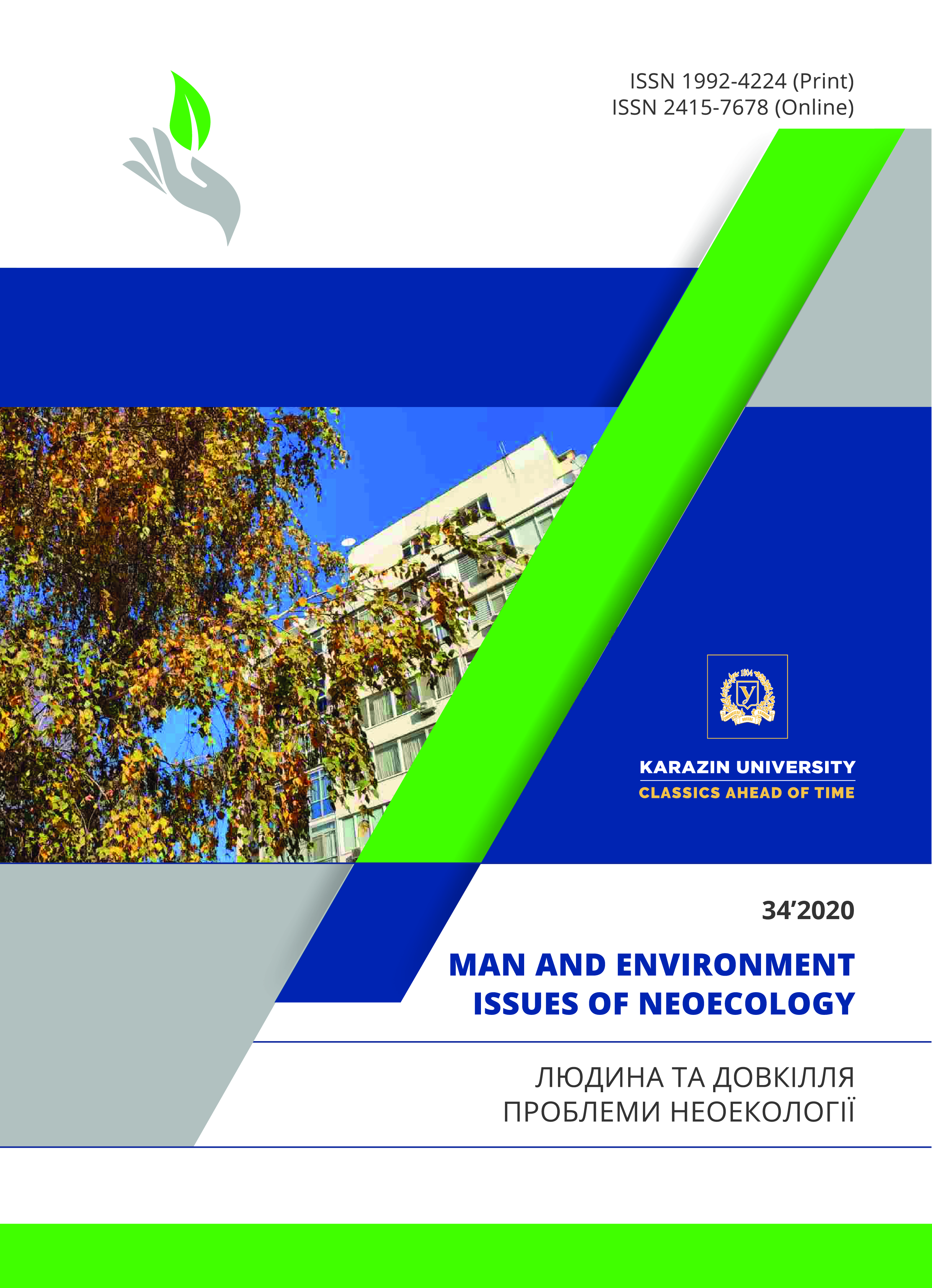Landforms as a Natural Recreational and Touristic Resource on the Example of Poltava Region
Abstract
Purpose. To study the Poltava region landforms as a natural recreational and touristic resource to optimize its use in tourism.
Methods. Analytical synthesis, comparison, deduction.
Results. Poltava region landforms due to their flat nature make the safe conditions for touristic activities. In compare to piedmont or low-hill terrain regions it attracts less attention of tourists, does not create the conditionals of high biodiversity and is characterized by high degree of anthropogenic development. The research was done for studying of geologic objects of Poltava region that can be interesting for tourists. We considered their location, origin, scientific and conservation value, perspectives for use in tourism. The origin of objects is connected to both endogenous (Rock - granite register", granitoid outcrops, Keleberda, Vysachkivsryi saline dome) and exogenous processes that are mainly erosive (Butova Gora, Brusia, Golovleva Krucha, Lysa Gora) and glacial (mount Piviha). All objects are components of the natural-reserve fund of Ukraine. To assess the significance of objects the points system was created based on their comprehensive nature. Most objects
are combined with other geological landmarks with natural and anthropogenic origin, natural water, areas with preserved vegetation that increases their value. Many of objects has a historical value (Rock - granite register", Keleberda) or are connected to important historical events (mountain Piviha) and the activities of famous personalities (Golovleva steep). This is a reason why the biggest amount of points was given to such objects as Rock – “granite register”, granitoid outcrops in the Kamiani Potoky village , Butova Gora, Keleberda.
On the other hand the lack the tourist infrastructure reduces the possibility of using some objects for tourism development. Thus, one of the most contrasting and attractive objects - Mount Piviha - is estimated by average number of points because of lack of tourist infrastructure.
Conclusions. The landforms of Poltava region as a natural recreational and tourist resource creates significant opportunities for development of different kinds of tourism, including cultural, walking, water, health, coastal, environment-oriented, scientific tourism and photo tourism. The creation of the recreation infrastructure will allow involving geological and geomorphological objects more actively to tourist activity and increasing efficiency.
Downloads
References
Halkiv, L., Kylyn, O. & Struchok, N. (2015). State and prospects of development of ecological tour-ism in Ukraine. Odesa National University Herald Series Economy, 20(3), 189–193. Retrieved from http://fs.onu.edu.ua/clients/client11/web11/pdf/vist_onu/ecoT20V3.pdf (In Ukrainian).
Pimenov, V. (2018). The development of ecotourism in Ukraine: basic concepts, problems and cur-rent status. Visnyk of Kharkiv State Academy of Culture, 52, 198–208. Retrieved from https://doi.org/10.31516/2410-5333.52.125115 (In Ukrainian).
Horishnyy, P. (2017). Morphological analysis of relief of berezhanske Opillya. Scientific notes of Ternopil National Pedagogical University named after Volodymyr Hnatyuk. Series: Geography, 43(2), 4–9. (In Ukrainian). Retrieved from http://nzg.tnpu.edu.ua/article/view/157440
Zinko, Y., Malska, M. & Ivanyk, M. (2014). Tourism in the Carpathian region: threat to the environ-ment and ways of sustainable development. Visnyk of the Lviv university. Series Geography, (45), 443–451. Retrieved from http://publications.lnu.edu.ua/bulletins/index.php/geography/article/view/1214 (In Ukrainian).
Netrobchuk, I. (2009). Recreational assessment of the relief of the Bugo-Styr interfluve of the Volyn upland. Scientific Bulletin of Volyn National University named after Lesya Ukrainka: Geographical Sciences, 10, 40–44. (In Ukrainian).
Tsaryk, P. (2014). Assessment favorable geology and geomorfological resources Podillia for recrea-tion. Scientific notes of Ternopil National Pedagogical University named after Volodymyr Hnatyuk . Series: Geography, (2), 83–93. Retrieved from http://geography.tnpu.edu.ua/wp-content/uploads/2016/11/163.pdf (In Ukrainian).
Tsaryk, P. (2017). Evaluation of recreational efficiency of landscapes of the national natural park "Karmelukove Podillia". Scientific notes of Ternopil National Pedagogical University named after Volodymyr Hnatyuk. Series: Geography, (2), 100–112. Retrieved from http://geography.tnpu.edu.ua/wp-content/uploads/2018/02/17.pdf (In Ukrainian).
Kovtunyk, I. (2016). Orographical resources as a touristical and economical wealth of Khmelnytska region. Efficient economy, (5). Retrieved from http://www.economy.nayka.com.ua/?op=1&z=4951 (In Ukrainian).
Bairak, O. (Ed.). (2003). Reserved treasures of Poltava region. Ukraine, Poltava. (In Ukrainian).
Matsa, K. (Ed.). (1993). Poltava region: nature, population, economy. Ukraine, Poltava. (In Ukraini-an).
Information about Poltava region (2020, August 29). Retrieved from https://polinfo.gov.ua/informatsiini-materialy/pro-poltavsku-oblast (In Ukrainian).
Law of Ukraine "On the nature reserve fund of Ukraine". (2020, August 29). Retrieved from http://www.eco-poltava.gov.ua/pzfzag.htm
Alieshugina, N., Baranovska, O. & Baranovskii M. (2015). Recreational and tourist resources of Ukraine with the basics of tourist resource science. Ukraine, Chernihiv. (In Ukrainian).
Stetsiuk, V. (2005). Ecological geomorphology and subsoil protection: tutorial. Kyiv. (In Ukrainian).
Alekseeva, T. (2013). The investigation of technogenic influence on the vegetation on an example of town Kremenchug. Man and environment. Issues of neoecology. (1–2), 127–133. Retrieved from https://periodicals.karazin.ua/humanenviron/article/view/970
Alekseeva, T. (2020). The Objects of Nature Reserve Fund of Poltava Oblast as a Factor of Ecological Tourism Development. Scientific Herald of Chernivtsi University, (824), 48 ̶ 54. Retrieved from https://geochnu.top/index.php/climat_geology/article/view/81
Authors reserve the right of attribution for the submitted manuscript, while transferring to the Journal the right to publish the article under the Creative Commons Attribution License 4.0 International (CC BY 4.0). This license allows free distribution of the published work under the condition of proper attribution of the original authors and the initial publication source (i.e. the Journal)
Authors have the right to enter into separate agreements for additional non-exclusive distribution of the work in the form it was published in the Journal (such as publishing the article on the institutional website or as a part of a monograph), provided the original publication in this Journal is properly referenced
The Journal allows and encourages online publication of the manuscripts (such as on personal web pages), even when such a manuscript is still under editorial consideration, since it allows for a productive scientific discussion and better citation dynamics (see The Effect of Open Access).





